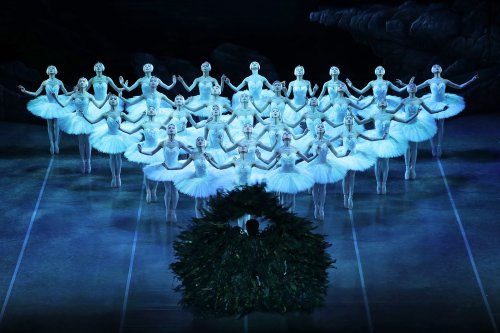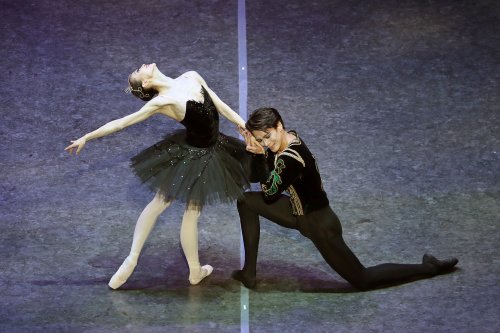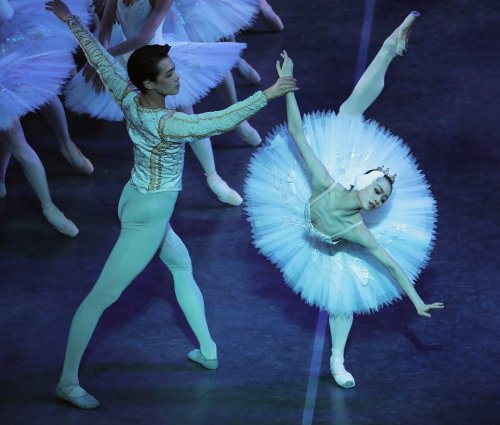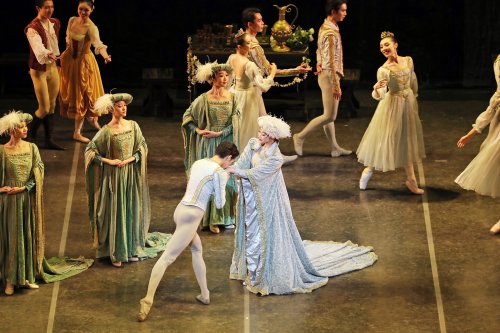Grand Swan Lake (Shanghai Ballet)
Forty-eight (48!) white swans slowly rise in formation, appearing magically out of the fog made for an unforgettable theatrical moment in a beautiful show.

Zhou Haibo as Rothbart with Swan Corps de Ballet (Photo credit: North America Photography Association)
[avatar user=”Sheila Kogan” size=”96″ align=”left”] Sheila Kogan, Critic[/avatar]
A recent iteration of the classic ballet Swan Lake was staged by Derek Deane and danced by the Shanghai Ballet and presented by the Shanghai Ballet with China Arts and Entertainment Group Ltd. at the David H. Koch Theater at Lincoln Center. The company called their version Grand Swan Lake because it promised to be bigger than any other, at least in the number of dancers on the stage. But was bigger any better? Actually, yes. I assumed that using 48 swans was just a gimmick to get attention, but it was a very effective dramatic device. Forty-eight white tutus in moving formation was impressive, and in the last act, all those swans magically rising up through the fog was really breathtaking, a memorably dramatic visual.
There is a reason why Swan Lake is a classic ballet that audiences want to see again and again. Like Shakespeare’s plays, it is rich and full of theatrical meat. The plot is complicated, but for those of you who don’t know it, here’s the basic story: (Because this is part fairy tale, a little suspension of disbelief is required…) Odette has been put under a spell by the evil sorcerer Rothbart (one of the great stage villains, usually called “von Rothbart”). Sadly, Odette will have to live forever as a swan, but the spell could be broken if a pure love vows to be ever true. The prince vows that his love-at-first-sight is pure and that he will be ever faithful.
But back at the castle, the prince’s mother has declared that he must marry, and she has arranged for all the most eligible young ladies of various lands to meet him at his birthday party. One of the ladies is a dazzling stranger, Odile, whom Siegfried enthusiastically chooses to marry. But as he makes that vow, Odile and her escort (who is Rothbart in disguise) laughingly reveal that they have tricked him into infidelity and now Odette is doomed. He races to the lake to see his beloved Odette and to ask for her forgiveness. But after sadly (so sadly) realizing her situation, she declares that she will kill herself (in ballet mime, she crosses one wrist over the other meaning: “die!”). She rushes offstage with Siegfried racing after her. Odette’s death breaks the spell that Rothbart has over the swans and he dies, almost melting into the rocks. Then Odette and Siegfried appear, rising to heaven in a boat, to be together forever.

Qi Bingxue as Odile and Wu Husheng as Prince Siegfried in the Shanghai Ballet’s “Grand Swan Lake” (Photo credit: North America Photography Association)
The story is mostly a frame for the visually gorgeous productions and the various detours of dancing, but it is also emotionally satisfying. It is customary for one ballerina to play both Odette (sad and fragile) and Odile (confident and seductive), making this dual role a dramatic and technical feat and a test for every ballerina who takes on the challenge. The inventive choreography of Marius Petipa has continued through the centuries to be the basic text for classical ballet and his patterns for the corps de ballet is unsurpassed (except maybe by Balanchine). Danced to the wonderful score by Pyotr Ilyitch Tchaikovsky, the ballet is full of entertainments and drama, and like other classics, interesting to see with different dancers and interpretations.
In these times when most dance performances lack a set of any kind, it was wonderful to see the extravagant and lush sets and costumes designed by Peter Farmer. He used jewel-toned colors for the international party guests and, of course, black or white tutus for the swans. Rothbart’s enormous, feathery cape was menacing and scary. Howard Harrison’s lighting designs gave the lake scenes an otherworldliness, and the party scenes a bright and celebratory look. Their designs helped to transport us to glamorous or ethereal locations, far from our everyday lives, which is one of the pleasures of story ballets.

Wu Husheng as Prince Siegfried and Qi Bingxue as Odette in the Shanghai Ballet’s “Grand Swan Lake” (Photo credit: North America Photography Association)
Charles Barker, who usually conducts the orchestra for American Ballet Theatre, led the New York City Ballet Orchestra. Tchaikovsky’s familiar and truly wonderful melodies sounded rich and supported the dancing perfectly. In fact, there were moments when Barker seemed to be aware of the dancer’s needs and momentarily adjusted the tempo – which wouldn’t have been possible if the music had been recorded. One of the saddest and most romantic pieces of dance music, to my mind, is the “White Swan Pas de Deux,” which highlights two uncredited violin soloists. It was gorgeous and heartrending.
The corps de ballet of the Shanghai Ballet was a fine group of dancers who move with a light quietness that was silky smooth. The four charming cygnets danced in perfect unison, and, as always, were a crowd pleaser. The various specialty dances were lively and fun. Wu Husheng was a handsome, ardent and regal Prince Siegfried, an excellent partner. Chen Yan was his mother, the elegantly royal Queen. And Rothbart (Zhou Haibo) was an evil bully, furiously racing around the stage, flapping his winged cape in a frightening manner.
Above all, there was Qi Bingxue who danced the major role (or roles) of Odette/Odile. She was extremely thin, but had a tensile strength that was remarkable (although it left her for a moment when it looked as if her fouetté turns might whip her right into the orchestra pit), but her steely arabesque on pointe brought deserved applause. Her Odette and her Odile were distinct, indicating her acting ability. The way she stopped struggling against Rothbart and snapped to obedient attention was chilling. And during the last scene, she had everyone wrapped in her pain; there wasn’t a sound in the audience. It felt as if everyone was breathing as one.

Wu Husheng as Prince Siegfried and Chen Yan as the Queen with Corps de Ballet in the Shanghai Ballet’s “Grand Swan Lake” (Photo credit: North America Photography Association)
However, despite the fine talents, the technical dexterity, and the beautiful artistry, it seemed that all the dancers in the company were just a little too careful, a little too cautious. This is an excellent company, but although there were moments of amazing theatricality, there was a general lack of that spark that raises individuals from really good to those with star power. It is difficult to define, but if you’ve seen the great stars of the ballet stage, you can feel that extra excitement that they create.
Nonetheless, the performance was very satisfying. The Shanghai Ballet provided that theatrical experience that brings us to a theater: the sense of having our emotions stirred and shared with a community of others in the audience. It was a deep pleasure.
Grand Swan Lake (Shanghai Ballet) (January 17 – 19, 2020)
Shanghai Ballet & China Arts and Entertainment Group Ltd.
Lincoln Center for the Performing Arts
David H. Koch Theater, 20 Lincoln Center Plaza, at 63rd Street, in Manhattan
For tickets, call 212-496-0600 or visit http://www.DavidHKochTheater.com
Running time: two hours and 40 minutes including one intermission






Leave a comment